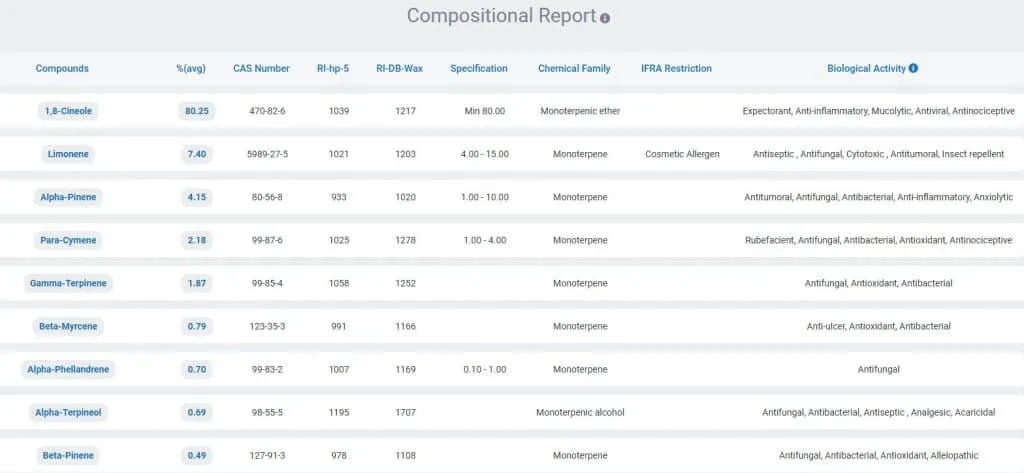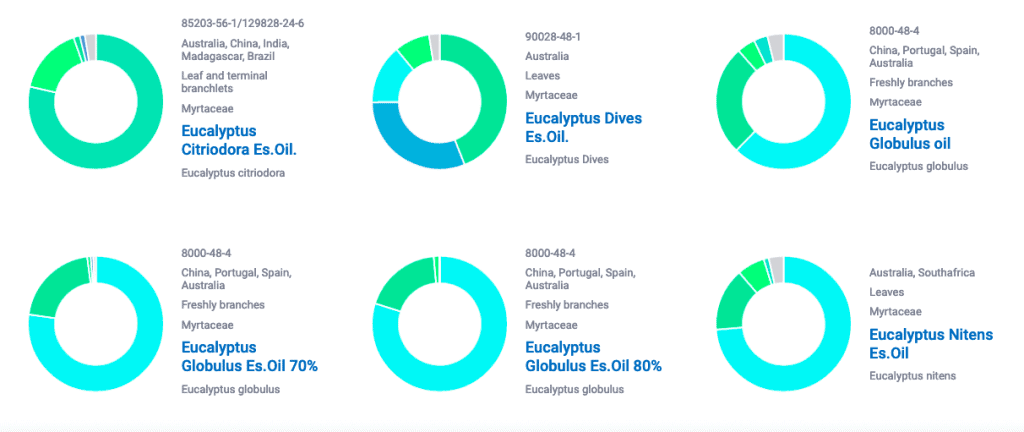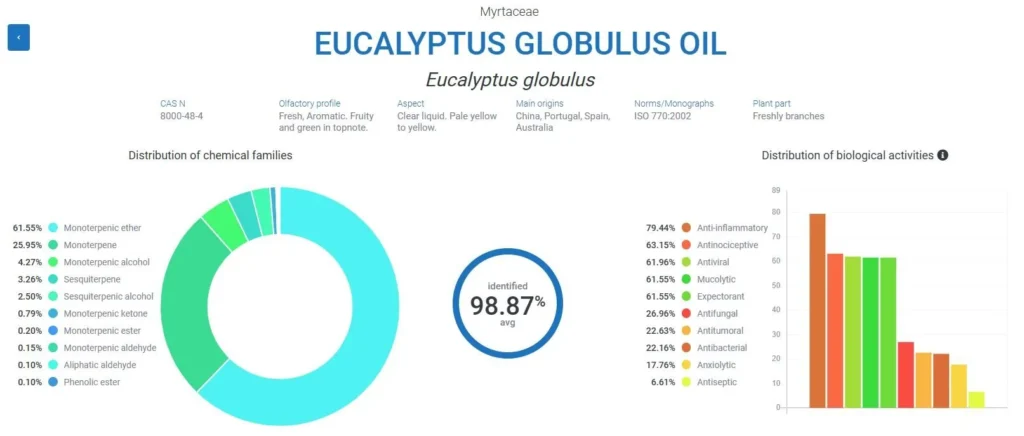| Botanical Name | Eucalyptus Spp. |
| Botanical Family | Myrtaceae |
| Part of the plant | Freshly pruned leafy branches |
| Cas Number | 8000-48-4 |
| FEMA Number | 2466 |
| Main Origins | China, Portugal, Spain, Australia. |
| Harvest Period | Whole year. |
There are more than 400 species of Eucalyptus. If we write “Eucalyptus” in our ChromDB web-app, we will obtain about 7 results, corresponding to several chemotypes. For example, the Citriodora species is rich in Citronellal, and the Dives species is rich in Phellandrene. In this monograph, we will speak about the most used chemotypes in the market: The “1,8-Cineole” (or “Eucalyptol”) rich ones.
The origin of this tree is Australian and it can reach more than 40 meters in height, especially in its native land, where some reach 100 meters in height. The most common Eucalyptol rich type is Eucalyptus Globulus and it was introduced in Europe in 1788. A notable feature is the drying of the soil because its roots absorb a large amount of water.
OIL PRODUCTION
This tree is mainly used for cellulose manufacture, and the essential oil could be considered a by-product.
However, eucalyptus oil production is one of the largest in the world (several thousand tons per year) due to its extensive use in pharmaceuticals (mainly as an expectorant).
The crude essential oil is obtained by steam distillation of several species rich in 1,8-Cineole.
Its essential oil is mainly used in fragrances, flavors, cosmetics, aromatherapy and pharmacy (Expectorant, bronchopulmonary decongestant, mucolytic, anti-inflammatory, antifungal…).
It has a herbaceous, balsamic and fresh fragrance, but with some unpleasant and pungent notes coming from some highly volatile substances. For this reason, and in order to obtain more of its active ingredient “1,8-Cineole”, the oil is purified by fractional distillation and marketed under various grades depending on the cineol content (70%, 80% or 99%).
Since Eucalyptus Globulus is the most common species on the market, typical composition for the crude and 80% rectified grade of this botanical product are detailed below, as appear in the ChromDB database:


CHEMISTRY
There are many species with a high 1,8-Cineole content, and sometimes they do not belong to the Eucalyptus family. This is the case of camphor oil rich in 1,8-Cineole. For this reason, it is important to control the “sabinene” content (maximum traces) to avoid adulteration with camphor oil.
ISO 3065 standardizes all species rich in 1,8-cineole, as a reflection of a market reality, since many producers and vendors are mixing species in order to obtain high eucalyptol products at a competitive price.
ISO 770 includes crude and rectified oils from Eucalyptus globulus. So in this norm we can find the trade products denominated Eucalyptus 70% and 80%, which are the oils rectified by fractional distillation in order to obtain 1,8-cineole with higher purities than 70% and 80%.
Apart from Eucalyptus Globulus, the main “Eucalyptol-rich” species used are the following: Polybractea; Radiata; Nitens; Smithii; Plenissima; Kochii and Blakely.
Following we’ll find a summary of the major compounds present in Eucalyptus Nitens and Eucalyptus Radiata:
SAFETY & REGULATORY
Monographs: ISO 770, ISO 3065, European Pharmacopoeia, FCC.
IFRA establishes EUCALYPTUS OIL as permitted. But we should be careful with possible cosmetic allergens, such as Limonene, Linalool or Geraniol.
For this reason, a maximum daily oral dose for adults of more than 600 mg is not recommended. Regarding cutaneous use, the maximum level of dermal application: 20%.







